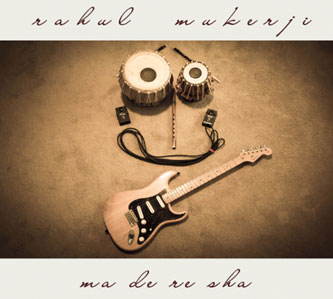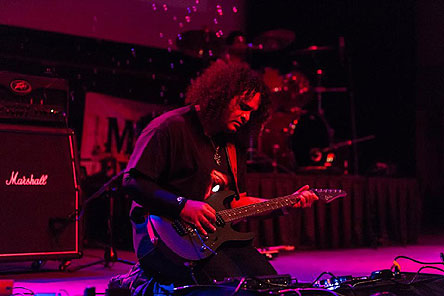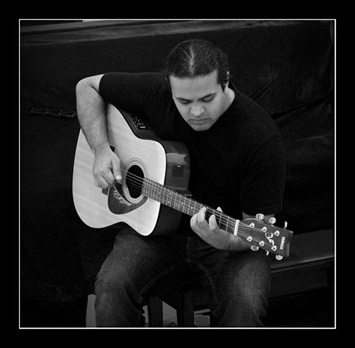 Indian
born / Maryland-based guitarist Rahul Mukerji is making waves
with his 2017 CD called Ma De Re Sha. Rahul’s
music is very cinematic and his fleet fingered guitar work sounds
influenced by masters such as Jeff Beck, Jan Akkerman and Al DiMeola.
All instrumental, Ma De Re Sha takes its cues from a mix of
driving, electronic instrumentals and Indian flavored, guitar-based
instrumental soundtracks, which is so popular in Indian movies. Speaking
about his wild mix of mystical Indian modalities meets Western jazz-rock
fusion in the following interview, Rahul tells mwe3.com, "To
be absolutely frank, I was more drawn to Western music, as far back
as I can remember. I was certainly exposed to classical Indian music,
but as a child I never really understood it and consequently never
really appreciated it." Performing all guitars, guitar synth,
e-bow and programming, Rahul adds in sampled sounds, tablas for a
traditional Indian percussive effect and modern drum programming to
give the sound a solid rock edge. Ruben Rubio adds bass and
Bruce is on additional drums and programming. Rahul Mukerji
picks up from golden era of 1970s fusion and blends in a dose of 1980s
electronic synth rock on his well-timed 2017 album Ma De Re Sha.
www.mukerji.us
Indian
born / Maryland-based guitarist Rahul Mukerji is making waves
with his 2017 CD called Ma De Re Sha. Rahul’s
music is very cinematic and his fleet fingered guitar work sounds
influenced by masters such as Jeff Beck, Jan Akkerman and Al DiMeola.
All instrumental, Ma De Re Sha takes its cues from a mix of
driving, electronic instrumentals and Indian flavored, guitar-based
instrumental soundtracks, which is so popular in Indian movies. Speaking
about his wild mix of mystical Indian modalities meets Western jazz-rock
fusion in the following interview, Rahul tells mwe3.com, "To
be absolutely frank, I was more drawn to Western music, as far back
as I can remember. I was certainly exposed to classical Indian music,
but as a child I never really understood it and consequently never
really appreciated it." Performing all guitars, guitar synth,
e-bow and programming, Rahul adds in sampled sounds, tablas for a
traditional Indian percussive effect and modern drum programming to
give the sound a solid rock edge. Ruben Rubio adds bass and
Bruce is on additional drums and programming. Rahul Mukerji
picks up from golden era of 1970s fusion and blends in a dose of 1980s
electronic synth rock on his well-timed 2017 album Ma De Re Sha.
www.mukerji.us
mwe3.com
presents an interview with
RAHUL MUKERJI
 mwe3:
You are originally from India. Where do you live now and where in
India are you from originally? What do you like best about where you
live now and how long have you lived in the US?
mwe3:
You are originally from India. Where do you live now and where in
India are you from originally? What do you like best about where you
live now and how long have you lived in the US?
Rahul Mukerji: I was born in a city called Allahabad in the
state of Uttar Pradesh, which is one of the northern states of India.
My father was part of the military so we moved residences a lot. From
my childhood until my undergraduate degree, I have lived in many states
all over India: Gujarat, Kerala, Maharashtra, Rajasthan, and Tamil
Nadu, to name a few.
I presently live in Germantown, Maryland. I came here to the United
States in 2002, so I’ve been here for 15 years. I love the big
melting pot culture in D.C. and in the Tri-state area in general.
From the music, to the visual arts, to the food, and the festivities,
you have a rich tapestry of multiculturalism that one can partake
in.
mwe3: Tell us about your growing up in India and who were your
musical mentors there? Most people are familiar with the great music
of Ravi Shankar. Was Ravi an influence and who else in India influenced
you musically and when did you start listening to guitar music in
general? India has a great connection with the electric guitar as
there’s many fine players there.
Rahul Mukerji: To be absolutely frank, I was more drawn to
western music, as far back as I can remember. I was certainly exposed
to classical Indian music, but as a child I never really understood
it and consequently never really appreciated it. Initially, my parents
were my musical mentors. My father plays a mean harmonica and my mother
plays the slide guitar. They both can play the keyboards and that’s
what I initially picked up. They played old Indian movie songs, and
what are now considered “Oldies” in western music. They
are also big into old Country music and my house always had country,
swing and popular numbers of the 60’s and 70’s mellifluously
flowing through it.
Fast forward to my ninth grade when I discovered rock music. I started
getting exposed to Def Leppard, Nirvana, Guns n’ Roses, and The
Doors. I immediately gravitated towards Phil Collen, Kurt Cobain,
Slash, etc. Around the eleventh grade is when I was introduced to
the guitar through a friend. Once I was turned on to the instrument,
I took the standard route of worshipping Paul Gilbert, Steve Vai,
Satriani and every Hair Metal band lead guitarist that ever put out
an REH instructional VHS tape. My university undergraduate years saw
me start to focus even more on guitar music as I discovered Al Di
Meola, John Petrucci, Steve Morse, and the formidable John McLaughlin!
Which is a great segue into saying that John’s playing with Shakti,
as well as Shawn Lane and Jonas Hellborg’s music is what brought
my attention to Indian music and the concept of fusion. For the first
time, I could relate and start to understand the intricacies and the
complexity of Indian music and the distinction between the Hindustani
and Carnatic streams of music.
India has indeed made its unique contribution to the world of guitar
with artists like Pandit Vishwa Mohan Bhatt, Pandit Debashish Bhattacharya
and Prasanna to name a few. To me, they have taken the instrument
and each contributed a unique voice grounded in the Indian music tradition.
We also have some fantastic rock, metal and fusion players!
As for Ravi being an influence, I’m still far too nascent in
my understanding of Indian music to even comprehend what the great
masters do!
 mwe3:
You mention the sound of tablas as being an influence on your music.
In what way could you compare the tabla sound with Western percussion
and which tracks on your new CD Ma De Re Sha feature tablas?
Do you try to recreate the Indian sound with guitar and have you played
electric sitars before?
mwe3:
You mention the sound of tablas as being an influence on your music.
In what way could you compare the tabla sound with Western percussion
and which tracks on your new CD Ma De Re Sha feature tablas?
Do you try to recreate the Indian sound with guitar and have you played
electric sitars before?
Rahul Mukerji: Tablas are a very interesting instrument, from
a western musical perspective. The drums and other percussions offer
a good palette for creating music, but the tablas, to me, add a whole
new dimension. The “bols” and the subtle nuances add a very
characteristic sound, which add to the melody, in addition to the
rhythmic backdrop they provide. I am also fascinated by the sound
of tablas in the context of heavy music. They seem to cut through
exceptionally well and take the music to a very different level.
I used tablas on "Exit 13", "Sita", "Zidd",
"Ma De Re Sha", "Train Ride From Siliguri" and
"Sinner". That’s exactly half of the tracks on the
album.
Yes, I do try and emulate certain glissando sounds, reminiscent of
Sitar, Sarod, and the Dilruba. I listen to certain ragas and try and
emulate the artists’ lines. And then when I’m composing
my own pieces, I’ll try and incorporate those techniques and
sounds into my own repertoire.
I have tried my hand at these instruments, but they are a whole new
discipline to themselves.
mwe3: Tell me about the Ma De Re Sha track “Children
Of I-2” – for example, how you came up with the track and
something about your melodic approach on the song. Do you prefer songs
with very melodic content or more jam-based improvisational fusion?
Do you have any favorite tracks on Ma De Re Sha or are they
all favorites?
Rahul Mukerji: At that time, I had just recently come across
the C#min7#5 chord. It had a beautiful ring and it went really well
with an A major barre chord with the B and E string played open. It
made for a simple but great sounding progression. I added the Dmaj7
and the Fmin9 to complete it. It felt right for the source of inspiration
as well. From a melodic approach, I definitely prefer strong hummable
lines. I jam out on the track and try multiple ideas and record anything
that sounds interesting. Once I have a string of ideas I try and tie
them together to form a theme or melodic contour.
My favorite tracks change from time to time. Presently, it’s
a toss-up between "Exit 13" and "Sinner". I really
love the basslines and structure of these two songs.
mwe3: What guitars are you using mostly on Ma De Re Sha
and what are some of your favorite guitars and amps? What can
you tell us about your guitar synth, Ebow and sampling you feature
on the CD. Which tracks are you playing the Ebow on mostly?
Rahul Mukerji: I’m primarily using my Fender Stratocaster,
Suhr, and the Brian Moore iGuitar8.13 on this album. I also used a
Line 6 JTV-89 occasionally, which is a beast of an instrument. These
are easily my favorite guitars. They are truly versatile and are well
suited for any and every occasion.
The Brian Moore iGuitar8.13 comes equipped with a 13pin RMC system
output that you can feed into different synth boxes. I use the Roland
GR-33 unit. I used the unit to play the synth flutes on Sita.
It’s an incredible tool for the working musician as it offers
multiple options. The synth, horn, flute sounds can be used to augment
the overall band sound when playing live. It tracks incredibly well
with the Brian Moore pickup. I’ve used it live a few times and
it has always been a blast to have fast guitar lines that are matched
by a synth or a flute!
 The Ebow
is another of my favorite tools to use live and in the studio. On
the album, I used it at the start of Baisakhi, using a Sitar
patch on the Line 6 JTV-89 and then on the Suhr for the Intro and
mid sections of Ma De Re Sha. It has a very beautiful haunting
sound when coupled with delay and reverb. You can truly get some great
soundscapes for movie scores using this little device.
The Ebow
is another of my favorite tools to use live and in the studio. On
the album, I used it at the start of Baisakhi, using a Sitar
patch on the Line 6 JTV-89 and then on the Suhr for the Intro and
mid sections of Ma De Re Sha. It has a very beautiful haunting
sound when coupled with delay and reverb. You can truly get some great
soundscapes for movie scores using this little device.
mwe3: Who else was involved in the recording and production
of Ma De Re Sha and how long did it take bring the album to
fruition? What did Bruce Ng and Ruben Rubio bring to the table and
add to the production of the CD?
Rahul Mukerji: Between life’s obligations, scrapped ideas,
rearrangements, computer crashes, looking for musicians, and designing
the album it feels like eons passed us by. I started working on the
album in earnest around the first quarter of 2011. It’s been
a good six years from its inception to its release!
Ruben took my songs to a completely new level with his contribution.
We gave him full creative freedom to do as he pleased without any
demo basslines and he blew us away with his pieces. His impeccable
technique and feel really enriches the songs, and the album as a whole.
I love that he used fretless bass on some tracks and then composed
some truly beautiful bass solos in the breakdown sections like Sinner,
Train Ride and Exit 13.
Bruce was the only other person completely immersed in the album recording
and production from day one. He’s been a fantastic pillar of
strength throughout this time. He’s been deeply involved in the
arrangements, instrumentation and other production aspects, in addition
to the actual drums tracks. He was even engaged in the artwork selection
and printing proofs of the album. And not to mention his help with
my crowdfunding campaign from the start to the end! He’s been
there every step of the way. To be honest, without him this album
would sound very different and possibly not as cohesive and thematically
developed.
mwe3: The cover art for Ma De Re Sha is excellent.
It almost looks like a face made out of musical gear! Are you trying
to make a statement with the cover art? Also, the back cover features
a great looking red colored painting. I know you’re also a painter
and graphic artist. What can you tell us about your other career as
a graphic artist and designer of fractals (how would you describe
Fractals to the layman?) and how does that side of your career interface
with your musical career?
 Rahul
Mukerji: Thank you! I’m glad you like the album cover. It
has a fun story behind it.
Rahul
Mukerji: Thank you! I’m glad you like the album cover. It
has a fun story behind it.
In my search for a good album cover, I worked on a lot of concepts
and cover ideas. The thought was to have a cover that was both interesting
and conveyed, in some form, the music that you could expect from this
album. I think I made a little over 150 different covers all of which
we rejected at some point! Eventually I reached an impasse, as I just
could not find a cover that clicked.
A few months later, Ruben finished his last track and we were ecstatic
at meeting this milestone. I wanted to mark the momentous occasion.
I came back from work and upon opening my door I realized the tablas
suddenly looked like a pair of eyes. I decided to make a goofy face
out of it. I used drum sticks for the eye brows, the tablas as the
eyes, a flute for the nose and a cable for the silly grin. I then
used two pedals to serve as ears and help complete the piece. For
the heck of it, I threw in my Stratocaster as well. The background
is my living room carpet, I just climbed on a stepladder and took
the picture.
I posted this on facebook with the title “Tracking is complete”.
And within minutes the post filled up with comments that this should
be the album cover. And yes, it very clearly has a lot of the instruments
used in the album, gives you a good insight into what you might hear
and it’s goofy enough to pique the interest of someone who may
be browsing through CDs. And that’s how a spur of the moment
idea clinched the album cover spot over other long thought out concepts.
The back cover was a strong contender for the album cover as well.
It is one of my favorite fractals that I’ve rendered. The color,
shape and texture on that piece came out beautifully. It got the consolation
prize and made it to the back cover.
Career wise, I’m a Project Manager at a Financial firm. That’s
my stable 9 to 5. My hobbies involve art, creative writing, music,
photography, and photo-manipulation among others. I use multiple mediums
of art from the traditional to the digital domain, creating animations,
posters, wood burnings, canvas and metal prints, and fabrics. These
different creative outlets are all intertwined with music. For the
fractal animations I create, I score them using my music. I also project
my fractals when I play live with my band Iritis. We are a psychedelic
progressive rock band so the fractal imagery works really well with
our music.
My album covers, posters and T-Shirt designs have also been used by
other musicians or as merchandise. And while creating art, I often
listen to music, sometimes one track on repeat for the entire duration
of the session. I’ve done a four-hour stint listening to Ben
Howard’s “Black Flies” while working on one particular
album cover.
 In fact,
I treated the whole album packaging as an art project and wanted the
listener to have a unique experience with this album. The top of the
booklet pages is decorated with all my rejected album covers, you
can also see some of my sketches in those pages, some of the licks
off the tracks are also noted there and it has a little narrative
and insight into the album making and song titles. It also has some
more of my favorite fractals in it and on the booklet cover.
In fact,
I treated the whole album packaging as an art project and wanted the
listener to have a unique experience with this album. The top of the
booklet pages is decorated with all my rejected album covers, you
can also see some of my sketches in those pages, some of the licks
off the tracks are also noted there and it has a little narrative
and insight into the album making and song titles. It also has some
more of my favorite fractals in it and on the booklet cover.
A good description of fractals is: “A graphic representation
of a mathematical set that exhibits a repeating pattern displayed
at every scale. They are created by repeating a simple process over
and over in an ongoing feedback loop.“
mwe3: What artists and guitarists today have the most influence
on your own music? Because your music spans a wide range of musical
styles, what artists do you feel are most representative of the continuation
of the classic jazz-rock fusion instrumental guitar sound?
Rahul Mukerji: I think John McLaughlin and Al Di Meola have
had a big influence on my playing. Steve Morse is a close second and
I love his playing whether it’s with the Dixie Dregs, his solo
stuff or with Deep Purple. Other than those, I enjoy listening to
a large variety of artists. Some off the top of my head are Aghora,
Andy Timmons, Bent Knee, Preston Reed, Michael Hedges, Kurt Rosenwinkel,
Pain of Salvation, God is an Astronaut, Freak Kitchen, Tommy Emmanuel,
Stanley Jordan, Tom Quayle, Bill Connors, and Yossi Sassi.
There’s a huge resurgence, in a sense, of the fusion aspect of
playing and there are some fantastic players out there. Tom Quayle
is certainly my favorite of the newer artists. You also have the amazing
Alex Machacek, Tim Miller and some of the Jam Track Central artists
are doing some great things in the jazz-rock fusion domain. In terms
of classic-jazz rock, Derryl Gabel, Greg Howe, Brett Garsed, Guthrie
Govan come to mind. This in conjunction with fusion monsters like
Jimmy Herring, John McLaughlin and Frank Gambale who are still out
playing.
Of course, we all mourn the recent loss of jazz-rock pioneer Larry
Coryell and the mind-bending Allan Holdsworth.
mwe3: So now with Ma De Re Sha out what other plans
do you have on tap for 2017 and beyond, including plans for live performances,
producing, writing and recording new music and creating art overall?
Rahul Mukerji: I’ll keep creating visual art pieces regularly.
I will probably look to create more paintings and traditional art
this year. I’ve just finished an art exhibition and will look
into other such opportunities to showcase new pieces. I need to get
back to creating new fractal animations. It’s been a year since
the last one was created!
Coincidentally my band Iritis is just about to release its EP titled
“Nothing Is Known”, and both Bruce and I are on that as
well. Bruce was also the Iritis drummer before he moved to Germany.
It just worked out that we have two releases literally months apart.
 So,
the band will have an EP release party soon and then some shows this
year to promote it and play out some new material. At some point the
band wants to go in to record a full-length album, so that might be
in the works as well.
So,
the band will have an EP release party soon and then some shows this
year to promote it and play out some new material. At some point the
band wants to go in to record a full-length album, so that might be
in the works as well.
From a solo music perspective, I’m taking part in some open mics
and other such venues that encourage artist collaboration to showcase
my album. And then hopefully I can rope in some musicians so that
we may play songs from the album live. I do have more material so
I could start to write a new album, but I’d like to take it a
small break for a while and get back to that at a later point.



